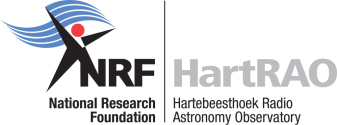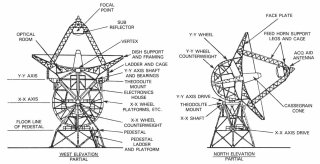
HartRAO Home >
DSS51 History >
DSS51 Sister Antennas
DSS 51 Sister Antennas
The ex-DSS 51 antenna at Hartebeesthoek is one of a number of similar 85' /
26m antennas built by the Blaw-Knox Corp. of Pittsburg, Pa., based on a
design by Howard E. Tatel of the Carnegie Institute Department of Terrestrial
Magnetism (DTM). They are listed in order of year of construction.
Polar-mount 85' Antennas

Click on the image for large version
The early antennas were polar mounted, i.e. the natural coordinate system is
Hour Angle (East-West motion) and Declination (North-South motion). Being
polar mounts, each antenna is different - the angle of the polar shaft to
the horizon is equal to geographic latitude of the antenna site. Figure from
Ref. 1.
NRAO 85-1 (Howard E. Tatel Radio Telescope), Green Bank, West Virgina, 1958 -
NRAO 85-1 was
the first major radio telescope at what is now the U.S. National Radio
Astronomy Observatory (NRAO) in Green Bank, West Virgina. Built in 1958, it
started operating in February 1959. As built this had a simple tubular
quadripod supporting the prime focus feed. The telescope still exists, but
it appears to be out of use.
University of Michigan Radio Astronomy Observatory (UMRAO) 1958 -
2013(?)
The UMRAO
85' telescope was built in 1958 under contract from the Office of Naval
Research. For many years it has carried out a programme monitoring the
fluxes of extra-galactic radio sources at 4.8, 8.0 and 14.5GHz under the
supervision of Hugh and Margo Aller. This and the Green
Bank 85-1 were the first 85' Blaw-Knox antennas to be ordered. In June 2012
the antenna was transferred to the University of Michigan departments of
Aerospace Engineering and Atmospheric, Oceanic and Space Science for
satellite tracking, end the long running AGN radio flux and polarization
monitoring programme of the Allers and co-workers.
NASA JPL DSIF 11 / DSS 11 Pioneer Station, Goldstone, California 1958 - 1981
The first Blaw-Knox antenna for the Jet Propulsion Laboratory (JPL) Deep
Space Instrumentation Facility was DSIF
11 at Goldstone in the Mojave Desert, California. JPL ordered three 85'
antennas in April 1958, based on the 85-1 and UMRAO design. Construction of
DSIF 11 began in May 1958 and was completed in November 1958. Originally
equipped with a 960MHz receiver, DSS 11 was upgraded in the manner
replicated on DSS 51, but was later used for receiver development until its
retirement in 1981. It is now a museum
exhibit.
The Deep Space Instrumentation Facility (DSIF) was renamed the Deep Space
Network (DSN) in 1963, and each site was renamed as a Deep Space Station
(DSS).
NASA JPL DSIF 41 / DSS 41 Woomera Station, Island Lagoon, Woomera, Australia 1960 - 1972
DSS41
Woomera Station was built in 1960 at the remote Woomera site. It was
converted for L-band and S-band operation at Cassegrain focus in 1964. Its
remote location led to its closure and demolition in 1972.
NASA JPL DSIF 51 / DSS 51 Johannesburg Station, Hartebeesthoek, South Africa 1961 -
DSIF 51 was
built in the Hartebeesthoek valley near Johannesburg in 1961. It was completed
in time to support the first Ranger mission to the Moon. It was
converted for L-band and S-band operation at Cassegrain focus in 1964. Mesh
surface replaced with perforated aluminium plate in 1968. Decommisioned by
NASA in 1974 and transferred to the South African Council for Scientific and
Industrial Research (CSIR) - who had been operating it for NASA - who
transformed it into the Hartebeesthoek Radio Astronomy Observatory (HartRAO).
NASA JPL DSIF 12 / DSS 12 Echo Station, Goldstone, California 1962 -
DSS
12 was built as an 85' (26m) antenna. It was rebuilt from June to
December 1978 as a 34m antenna operating at S- and X-band, in the DSN's
"34-m standard subnet". The upgrade is described in Ref. 2. The Polar axis
is described as having a spherical roller thrust bearing below the lower
radial bearing. It was retired in 1996, and became the Goldstone-Apple
Valley Radio telescope (GAVRT) /
Michael J. Klein Radio Observatory, and is used for educational purposes.
Weight is 850000 lbs.
Harvard University Fort Davis, Texas 1962 - 1991
Completed in July 1962, the Fort
Davis 85' telescope built by Harvard University was used for a variety of
research programmes. It was dismantled after its role was taken over by the
VLBA antenna built a few hundred metres away in 1990.
NRAO 85-2 and 85-3, Green Bank, West Virgina 1964 -
NRAO 85-2 and
85-3 were built in 1964 and could form an interferometer together with
85-1. They are equipped with co-axial 2.25+8.3GHz feeds, permitting
dual-frequency interferometry. Photos show these to have latticework
quadripods. The NRAO webpages suggest they are no longer in use.
85-1 and 85-2 were used for variable source monitoring, and 85-3 for pulsar
monitoring. 85-3 was also used for geodetic VLBI observations.
DSS 42, Tidbinbilla, Australia, 1965 - 2000
DSS 42
was a polar mount 85', the first antenna built at Tidbinbilla, near
Canberra. As built, it appeared very similar to DSS 51 after the S-band
upgrade. It was converted to 34m diameter from October 1979 to May 1980, as
part of the "34-m standard subnet" of the DSN. It was dismantled in December
2000.
DSS 61, Robledo, Madrid, Spain 1965 - 2009
DSS 61 was a polar mount 85' antenna. It was converted to 34m from August 1979
to March 1980. It then formed part of the DSN's "34-m standard subnet".
From 1993 June 04 to August 26, DSS 61 was out of commission while supporting the Ulysses
mission owing to the
upper polar shaft bearing having to be replaced. DSS 61
was decommissioned in 1999 and used in the programme "PARTNeR" for education
and radio astronomy from 2003.
DSS 62 Cebreros, Madrid, Spain 1967 - 1981
DSS 62
was a polar mount 85' antenna. It operated from 27 December 1966 to 30
November 1981. DSN's Deep Space History webpage
notes "After NASA declared the station surplus to its operational needs in
1983, it was donated to the Spanish government".
X-Y mount 85' Antennas

Click on the image for large version
The design was modified to an X-Y mount, achieved essentially by making the
polar axis horizontal. In contrast to Azimuth-Elevation mounts, this design
permits tracking through zenith. They were designed to slew at up 5 degrees
per second, but derated to 3 degrees per second in practice, compared to 1
degree per second for DSS 11, 41 and 51. Versions were built with feeds at
the prime focus and at the secondary, Cassegrain, focus. The latter is
shown in the diagram above (from Ref. 3). The STADAN X-Y mount antennas
weighed 882000 lbs, or approximately 400 metric tonnes, and stood 120 feet,
or 36m, high (Ref. 4).
STADAN ULA Fairbanks / Gilmore Creek Tracking Station, Alaska 1962 - 2005
The NASA STADAN Gilmore Creek Tracking
Station was located 22km from Fairbanks, Alaska. It was part of the the
Spaceflight Tracking and Data (Acquisition) Network (STADAN) and was known
as the Fairbanks (ULA) Station. It later became the Gilmore Creek
Geophysical Observatory. It operated an
85' X-Y antenna owned by NOAA/NASA. The feeds are mounted at the prime
focus. Fate of the antenna after
operations closed in December 2005 is unknown.
STADAN ROS Rosman Satellite Tracking Station, North Carolina 1963 -
1981, NSA 1981 - 1995, PARI 1999 -
The NASA Rosman Satellite Tracking Station, located in the Pisgah National
Forest 50 miles from Asheville, North Carolina, operated from 1963 and
includes two 85' antennas. It was the STADAN ROS station. Note that photo
on P51 of Ref. 4 (pdf P95) is not Rosman as the left antenna is a 64m -
probably Tidbinbilla? NASA closed the
operation in 1981 and it was taken over by the National Security Agency
(NSA) for intelligence gathering. It was closed in 1995 and in 1999 was
reopened for education, training and research purposes as the Pisgah
Astronomical Research Institute (PARI).
The 85' antennas are both X-Y mounts capable of 3 degrees / second slew
rates.
MSFN Goldstone 1965 - 1985(?) DSS 16 1985(?) - 2006
Built to support Apollo by the Manned Space Flight Network (MSFN). Did this
become the Goldstone STADAN station when the MSFN and STADAN networks were
merged in May 1971 to form the Spaceflight Data Tracking Network (STDN)?
Transferred to DSN around 1985 as DSS 16. Decommissioned from February 2006.
MSFN / DSS 44 Honeysuckle Creek, Australia 1967 - 1981, DSS 46
Tidbinbilla 1981 - 2009
DSS 44 was
an 85' antenna built between February 1965 and December 1966 at Honeysuckle
Creek in Australia. This antenna was originally part of the Manned Space Flight Network
(MSFN), and provided the first
pictures of man walking on the Moon.
In 1981 the Honeysuckle Creek antenna was moved to Tidbinbilla, where it
was renamed DSS 46. It was the last operating DSN 85' antenna as it is being
decommissioned from 2009 August 1.
MSFN Fresnedillas Station, Spain 1967 - 1985, DSS 66 Robledo 1985 - 2008
The Fresnedillas Station 85' X-Y
antenna was built to support Apollo as part of the MSFN. In 1985 it was
dismantled and moved to Robledo to become DSS 66. It was decommissioned on
30 September 2008.
DSS 16, DSS 46, and DSS 66 latterly formed "The 26-m subnet", used for
S-band communications. In their final form they were unique in having no
quadripod, the subreflector being supported by the feed.
STADAN 21 ORR Orroral Valley, Australia 1965 - 1985,
Mount Pleasant, Tasmania 1985 -
The NASA STADAN ORR facility at Orroral
Valley, 50km south of Canberra, Australia, also had an 85' X-Y mount
antenna. It operated from 1965 to 1985. This antenna was then shipped to
Mount Pleasant, Tasmania, where it is operated by the University of
Tasmania.
Azimuth-Elevation mount
DSS 13 Venus, Goldstone 1962 -
DSS
13 was built to support Project Echo, in which signals were bounced off
Echo satellite, a large metallised balloon. The support pedestal was quite
different from the polar and X-Y mounts.
This list is likely to be incomplete, and errors are inevitable.
Back to DSS 51
History.
References
- "Technical Manual, Operation and Maintenance, Antenna Support Equipment
Group (85-foot Antenna)", 1968, JPL TM 00623, Figure 1-2
- "26-Meter Antenna S-X Conversion Project", E. Burnell et. al., 1982, JPL
Publication 82-26
- "NASA Historical Data
Book Volume II Programs and Projects 1958-1968" by L N Ezell, 1988, NASA
SP-4012, p567
- "Read You Loud an Clear - The Story of NASA's
Spaceflight Tracking and Data Network" by Sunny Tsiao, 2008, NASA
SP-2007-4232, p47



